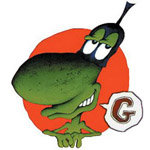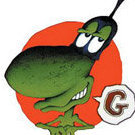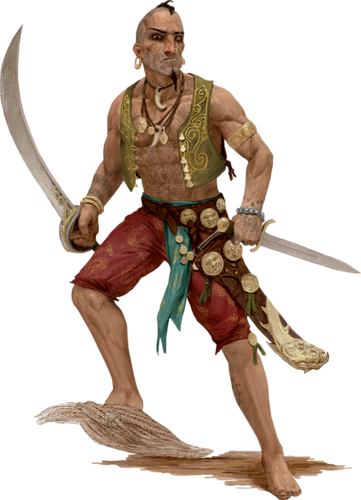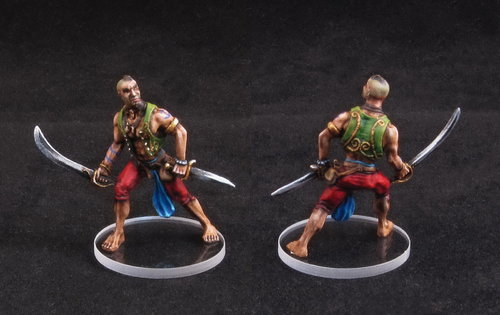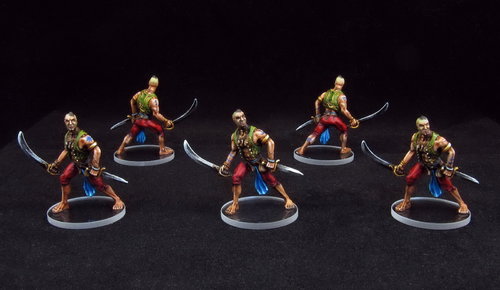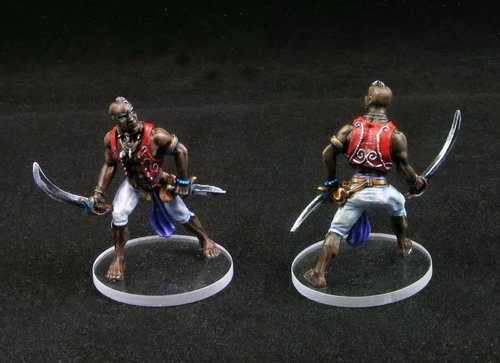Here's the english version of my pirate painting tuto, that should be included in one of the future Compendiums. Thanks to Jay Adan for the proofreading.
Yo ho ho! And a bottle of rum!
Foreword
The number of pirates in Conan being substantial (15 miniatures + 5 alternate minis), and their lifespan during the game often brief, my goal is to paint them to a decent standard without spending as much time as on heroes or monsters miniatures. So I tried to create an optimized sequence to paint several minis simultaneously, "assembly-line-mode".
I decided to paint the figures in groups of 5, each group having a distinct color scheme, to get rid of colored base markers in most scenarios. Also, it’s tedious to paint many identical minis simultaneously (everyone has their "max" number, mine being five)...
The color scheme for the 1st group of 5 pirates will follow Adrian Smith’s original art. It’s the one that I’ll describe in the sequence below.
Note: I won’t address basing, since I re-base my Conan minis with transparent acrylic bases. Basing is a broad topic, which can go from the most basic and quick (just paint the base with a single color) to the most elaborate and long (create a base from scratch).
A little bit of technique
No advanced techniques for these hordes of vile pirates. I’ll mostly use basic techniques: washing, blending, drybrushing. And just a bit of glazing at the very end.
Regarding washing, blending, and glazing, I invite you, friendly reader, to refer to the article by Martin Grandbarbe in Compendium Vol 2. Now to drybrushing...
Glossary
Drybrushing: This technique consists of using a flat or round brush (anything but a pointed brush) and undiluted paint (or barely diluted). Load the brush with paint, then wipe it by brushing on a clean paper towel until almost no paint remains on the paper. Then, brush the mini, without applying too much pressure. The near-dry paint deposits on the raised edges of the mini. It allows you to highlight very quickly. The look is typically rougher than with blending, although it’s possible to create extremely subtle gradations using drybrushing (requires time and experience, of course).
Paint ranges
I use a bit of everything, depending on the case. Usually, a lot of Vallejo (Note: Vallejo and Prince August are the same, only the label changes).
On these figures I will use Army Painter (AP), Games Workshop (GW), Vallejo Model (VM), Vallejo Game (VG), and Vallejo Model Air (VMAir) products. I’ll specify the exact references and designations, but also the "normal" names (for example "Blue" instead of "Dead arctic hamster vomit"...).
And I will try to not mix colors, once again to optimize painting time.
Sequence
1- Deburring, washing, then spray-prime with Flesh (Barbarian Flesh AP spray primer).
Deburring (removing mold lines) is a tedious but necessary step: remaining mold lines are an eyesore once the paint-job is complete.
After deburring, tiny bits of plastic and roughness often remain on the mini. To correct this and get smooth surfaces, just take a small stiff brush, soak it in acetone and brush it on these areas. It's a trick from the famous Rémy Tremblay, it works quite well on PVC minis (liquid glue for model kits, as used by Martin G., also works very well!).
Washing (with soapy water) eliminates any trace of finger grease deposited during deburring and ensures good primer adhesion.
2- First, I paint the eyes. That's what gives life to a miniature, and it's usually easier to paint them first. A good measure of off-white on the eyes (Ivory VM 918), then a thin vertical line of black to make the pupils (Matte Black AP). If it goes over the edges, no problem.
3- I correct what has gone over with Flesh paint (Barbarian Flesh AP). I prefer avoiding huge manga-style eyes. Admittedly, a pirate is a sailor, but it's not Sailor Moon.
4- First shading of the skin. I pick a ready-to-use Flesh wash, brownish-red (Reikland Fleshshade GW). A layer of diluted wash, applied everywhere (except in the eyes that have just been painted, duh ...). Then, the same wash, undiluted, applied only in the shadow areas and hollows.
If all goes well, the wash of the first mini has dried when I finish that of the 5th.
5- A light drybrushing with flesh paint to bring out the detail (Barbarian Flesh AP). Then a very light drybrushing with light flesh paint (Flesh Tone VM 815).
6- I highlight the skin with diluted light flesh, by doing small localized blends (Flesh Tone VM 815). To simplify the blending process as much as possible, I apply only one or two very thin and diluted layers, placed locally.
Likewise, I highlight areas that the previous drybrushing did not reach (abs, etc.).
And I paint the edge of the ears (whose sculpt is not very prominent), as well as the nails of the feet and hands.
All this makes it a long step, since you must treat many small areas. You can skip this step but the surface of the skin will be less "clean and smooth" in the end. And now I hear you saying "Clean? Are you kidding, this thing is as subtle as Kim Kardashian's make-up." Yes, indeed. But it's normal, it'll get better after. I assure you. It's because he’s not dressed up yet...
7- Hey presto, I paint the pants red (Pure Red AP), and the vest yellowish-green (Japanese Uniform VM 923). I apply several layers to get a good opacity.
8- I shade the pants with a ready-to-use dark-red wash (Carroburg Crimson GW). A first layer applied everywhere, then 1 or 2 extra layers just in the shadows areas and recesses. I take this opportunity to put a shot of the same dark red wash on the dude’s bottom lip.
Same for the vest’s shadows, but with a ready-to-use dark green wash (Biel-tan Green GW).
9- I paint the belt turquoise (Blue-green VM 808), the sword and the dagger silver (Chainmail Silver VG 053). I repeat if necessary, to get a good opacity.
10- I shade the belt by applying a dark blue wash (obtained by highly diluting Prussian Blue VM 965 with water).
Regarding the blades, I treat them "NMM style", i.e. by forcing the shadows as in pencil drawing or traditional “2D” painting. I blend with black, applying several successive black washes (Black Ink VG 094) on increasingly smaller areas, to gradually increase the opacity.
The upper part of the dagger’s blade has shadows that go to the handle, the lower part has shadows that go to the tip. For the scimitar, it’s the opposite, the upper side parts have shadows that go to the tip, the lower sharp has shadows that go to the handle.
Note: The upper edge of the scimitar has shadows that go up to both sides, towards the handle and the tip (it's invisible in this picture, see the last pictures).
11- I highlight the edges of the belt with a blend of light turquoise, slightly diluted (mixture of Blue-Green VM 808 + Ivory VM 918).
The hair, necklaces, belt, purse, and handles of the swords are painted brown (Flat Earth VM 983). Try not to go over the edges, even if the following steps will cover most of the mistakes.
The left bracelet is painted with a light blueish grey (Pale grey blue VM 907).
And I raise the highlights on the blades with a blend of silver paint, slightly diluted (Chainmail Silver VG 053).
12- The shark teeth and various necklace charms are painted off-white (Ivory VM 918).
The swords’ guards, right bracelet, left armband, and vest’s embroidery are painted gold (Polished Gold VG 055). The embroidery is super thin and requires precision; however it’s not tragic if you go a bit over, it will be hidden soon after.
13- The golden parts and necklace charms are shaded with a hazelnut brown wash (diluted Brown Ink VG 092).
I apply this same wash on the vest’s embroidery, following the sculpt, and without going too much on the green surface. It adds contrast and hides the possible mistakes of the previous step.
14- I put some golden highlights on the guards of the swords, the left armband, and the right bracelet (Polished Gold VG 055).
I finish the "NMM style" of the blades with chrome paint, building up the last highlights of the blades and their edges (Chrome VMAir 064). Straight after, I put some last highlights on some golden areas (buttons on the vest, among others), with small dots of Chrome.
And I draw the ultimate weapon of the average mini painter, namely the dark brown wash (Agrax Earthshade GW) that I will apply in specific areas: On the belt and the purse, at the junctions between the skin and the other elements, in the skin’s shadows (under the arms, under the pecs, etc.), in the face’s shadows (eye contours, nose, wrinkles, ears, around the jaw), and on the necklace’s threads.
It allows to raise the skin’s contrast, to shade the leather parts, and to outline the different elements thus increase the mini’s readability.
15- I highlight the tips of the necklace’s charms, by doing blends with slightly diluted off-white that I pull to the tip (Ivory VM 918).
I apply a diluted black wash (Black Ink VG 094) on the left bracelet, the belt and the purse, in the darkest shadows of the pants, on the hair, and on the swords’ handles.
16- The eyebrows and the goatee are painted black (Matte Black AP).
I put dots of pale blueish gray on some pearls of the left bracelet (Pale blue gray VM 907).
And I highlight the belt and the purse with a blend of orange-ish brown (Orange brown VM 981).
17- Some final details to customize each mini: Scars, tattoos, and stubble beard / shaved head.
Regarding scars, I start by painting lines of reddish-brown flesh wash (Reikland Fleshshade GW), and I repeat to increase opacity.
Regarding tattoos, I draw them with slightly diluted blueish gray (Russ Gray GW).
Regarding stubble beard and shaved head, I do a local glaze of greenish gray (Stone gray VM 884). This glaze is a translucent layer that creates the illusion of stubble.
18- I complete the details.
For the scars, thin lines of light flesh just above (or in the middle, if possible) the previous flesh wash strokes (Flesh Tone VM 815).
The tattoos are completed with dark blue, painted in the middle of previously painted patterns (Prussian Blue VM 965).
The beard and the skull receive a very thin and diluted olive-green glaze (Olive Green VM 967).
Almost there…
19- A coat of matte varnish spray (Anti-shine AP spray) to protect the minis during handling.
Then I put touches of gloss varnish (gloss varnish VM 510) applied selectively on the necklace’s charms, and on the highlights of some metal parts: silvery tips of the sword and dagger, top of the dagger's pommel, top of the dagger’s guard, top of the left armband. It allows to find back a nice gloss on metals, which has been flattened by the matte varnish spray.
Finally, I glue the dudes on their acrylic base.
And here are some pictures of the finished miniatures, taken with good lighting.
The scum is ready to plunder the hyborian seas and to swallow gallons of rum.
Yo ho ho! And a bottle of rum!
Hereunder is a second pirate squad, painted with another color scheme, but following the same sequence.
Hoping that it helps you, thank you for your attention, friendly reader!


